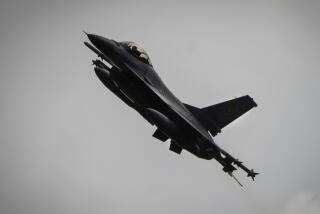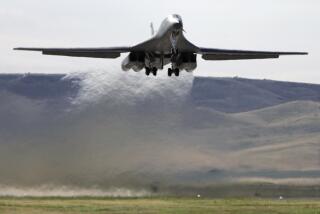AF Relieves 3 Officers in Ronald Brown Crash Probe
WASHINGTON — The Air Force announced Thursday that it has relieved three senior officers from command following an investigation of the April 3 air crash in Croatia that killed Commerce Secretary Ronald H. Brown and all 34 other people aboard.
The service said that the action came because Maj. Gen. Charles R. Heflebower, commander of the 17th Air Force, had “lost confidence” in the ability of the three “to effectively discharge their responsibilities.”
Air Force officials declined to provide further details, saying that the investigation was still under review and that the results would not be made public for another two weeks. They also cautioned that Thursday’s action does not preclude court-martial of the three officers later.
However, private analysts speculated that the swift action by the Air Force this early in the process suggests that investigators may have found widespread deficiencies in the efforts by top-level commanders to ensure that such “VIP” transports follow safety procedures.
Although Brown’s flight was considered routine, the CT-43A transport confronted a spate of dangerous conditions, having to deal with unusually heavy storms and an outdated ground control system at the airport at Dubrovnik, Croatia, where the plane was to have landed.
Gen. Ronald R. Fogleman, the Air Force chief of staff, has vowed to hold senior commanders responsible when such mishaps occur. The Air Force had been criticized in some earlier cases for allowing high-ranking officers to escape punishment while junior officers were blamed.
The three officers relieved of their commands include Brig. Gen. William E. Stevens, commander of the 86th Airlift Wing at the time of the crash; Col. Roger W. Hansen, the vice commander then, and Col. John E. Mazurowski, commander of the 86th Operations Group.
Only a few days before the crash, Stevens had removed Lt. Col. James Albright, the commander of the 76th Airlift Squadron, who reportedly had raised concerns about the safety of procedures then being followed by pilots of flights carrying VIPs such as Brown.
One person familiar with the inquiry said that investigators have interviewed Albright extensively, suggesting that they have placed a good deal of weight on his assessment of the procedures being used at the time of the crash.
Just after the crash involving Brown, the armed forces newspaper Stars and Stripes quoted a pilot in Ramstein, Germany, where the airlift operation is based, as saying that Albright had objected to “pressure from above” to allow such VIP flights into airports such as Dubrovnik.
Aviation Week magazine reported after the crash that neither of the pilots of the aircraft had landed at Dubrovnik airport before and that they were completing their fourth flight of the day when the accident occurred.
Officers familiar with the situation suggested Thursday that there also are questions about whether the Air Force had surveyed the airport at Dubrovnik properly to certify that its facilities and approach patterns meet U.S. standards.
The crash of the CT-43A transport shook official Washington, prompting a major review of Air Force passenger-plane safety procedures and emergency upgrading of equipment, including new navigational equipment and cockpit voice- and data-recorders.
Only a week before the fatal crash, the Air Force used the same plane--a military version of the Boeing 737--to transport First Lady Hillary Rodham Clinton on a trip through the Balkans.
Among the questions raised by the crash is whether the pilot should have tried to land in such bad weather at an airport that lacked a sophisticated landing system.
The Air Force announced in mid-May that it intends to buy satellite-aided navigational systems for use in its passenger planes as an interim response to the April 3 crash, to help pilots tell when their planes are not on intended approach paths.
In addition, Defense Secretary William J. Perry ordered that all military aircraft carrying passengers be equipped with voice- and flight-data recorders.
The Air Force action Thursday is in stark contrast to the service’s handling of an April 1994 tragedy in which two Air Force F-15C fighters mistakenly shot down a pair of U.S. Army helicopters over northern Iraq, killing 26 U.S. and foreign military personnel and diplomats.
In that case, the Air Force initially allowed the senior officers involved to escape punishment and instead court-martialed a young captain, who later was acquitted.
After the court proceedings ended, Fogleman personally ordered the senior officers disciplined.
Air Force officials said that Thursday’s decision to relieve the three officers was made with the approval of Gen. Michael Ryan, commander of U.S. air forces in Europe. They said that the three will be reassigned.
More to Read
Sign up for Essential California
The most important California stories and recommendations in your inbox every morning.
You may occasionally receive promotional content from the Los Angeles Times.










